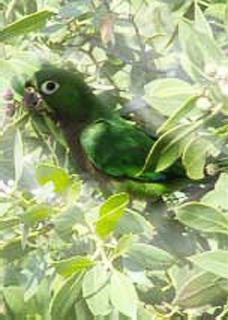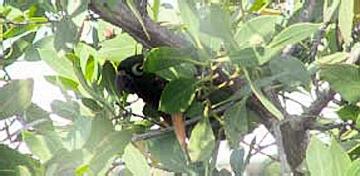|
|  The Olive Throated Parakeet
There is no information given on the mating behavior of the Olive-throated parakeet but based upon research of similar parrot families, the birds do have a mating call that is sung by the male to make the female aware that he is ready to mate. Unlike most birds where male/ female bonds occur only during the breeding season, and function only in coordinating parental care, Olive-throated parakeets are monogamous. Perennial monogamy, or year-round pair bonding, occurs in at least a dozen avian families, including cockatoos and other parrots. They breed one time during the spring between April and May. At this time they look for nesting sites in termite holes and lay three to five eggs which hatch in 26- 27 days. After hatching, it takes about 50 days until the fledglings are ready for their independence.
Olive-throated parakeets feed mostly on fruits and vegetables. They eat buds and fruits of many trees and cultivated crops. Because of their strong bill and muscular tongue they are able to seek out fruits and break seeds that would otherwise be difficult for other animals to crack. They associate in flocks to share information about food; like flight calls and frequent chatter between flying birds and those in fruit trees exchanging information. When feeding, parrots are methodical and slow-moving, using their bills as extra “hands” when searching for ripe fruit. Many of the plants that the parakeet feeds on have built up chemical and mechanical defenses to ward off any possible herbivores. Parrots, though, have become practically immune to these plant’s defenses. To avoid mechanical barriers, parrots’ bills have evolved the ability to crush the largest seeds and destroy most of the seeds they ingest. To fight the chemical defenses of these plants, they digest clay from riverbanks to detoxify the toxic chemicals in the seed or fruit. Alternatively, they avoid poisoning themselves by eating small amounts of toxic seeds and combining that with a larger amount of harmless seeds, therefore substantially decreasing the potential harm. Sometimes Olive-throated parakeets will damage cultivated crops and become a pest. They are the most persistent immature- seed predators in the rainforest and make it hard for farmers to harvest crops thoroughly. They also are predators to plants and fruit trees by interrupting and disrupting a tree’s dispersal strategy and hindering germination. Parrots, though, make it possible for other organisms in their ecological community to eat. When lurking through the rainforest canopy, avoiding predators, parrots often drop some of the fruits and seeds that they have been collecting. This allows smaller organisms that are not in the canopy like termites to eat. They also disperse the seeds of many plants. People often have parrots as pets. They are the most important group in the wildlife trade economically, and represented a F.O.B. (free on board) value of about $827,757.US in 1997. This value decreased to about $450,004. in 2000 because of smaller numbers being exported. Olive-throated parakeets are also important in attracting tourists in Caribbean and tropical areas. Click here to return to the main page for Caribbean Critters
|

 It’s hard to say what you might find
most exotic about island life, but a good
bet is that you’d be thrilled with the flocks
of parakeets that fly over at all hours of
the day. They are Olive-throated parakeets
(Aratinga nana), once known as
Aztec Parakeets. These birds announce
themselves with their noisy, shrieking
chatter as they fly in tight, fast-moving
little flocks, dive-bombing into trees that
are a bit higher than the rest. Just as suddenly,
their screeching will stop and they
sit still like little statues, looking around,
until slowly they begin moving. Before
long they make a circus of twig-climbing
and, more than anything, preening and
interact with one another.
It’s hard to say what you might find
most exotic about island life, but a good
bet is that you’d be thrilled with the flocks
of parakeets that fly over at all hours of
the day. They are Olive-throated parakeets
(Aratinga nana), once known as
Aztec Parakeets. These birds announce
themselves with their noisy, shrieking
chatter as they fly in tight, fast-moving
little flocks, dive-bombing into trees that
are a bit higher than the rest. Just as suddenly,
their screeching will stop and they
sit still like little statues, looking around,
until slowly they begin moving. Before
long they make a circus of twig-climbing
and, more than anything, preening and
interact with one another.


